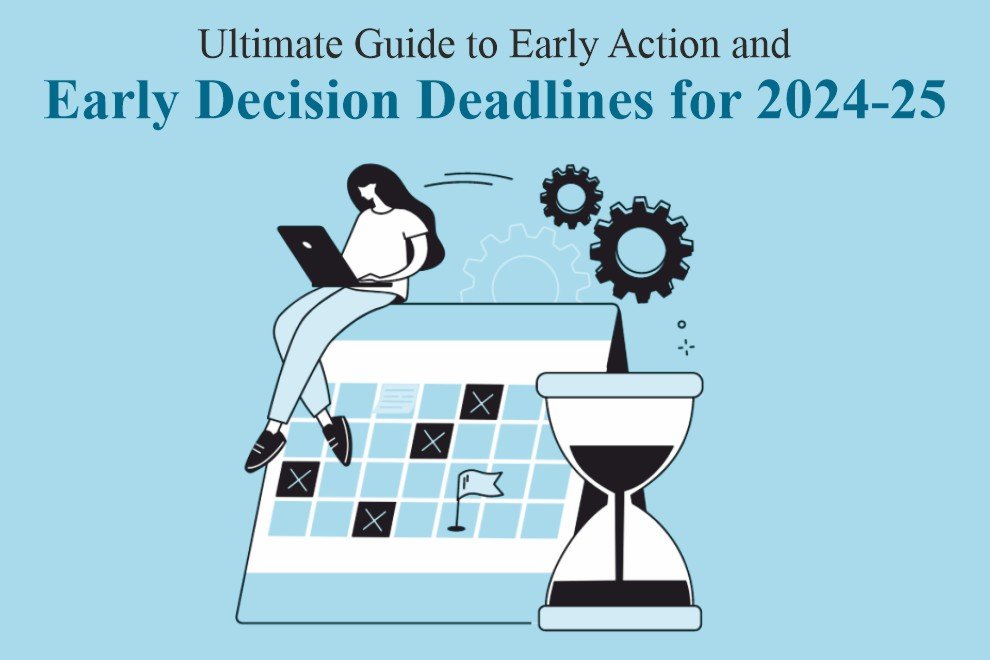Understanding the college application process can be overwhelming, especially when it comes to Early Action (EA) and Early Decision (ED) deadlines. These early deadlines are crucial for students aiming to secure their spots at their dream colleges ahead of the regular admission cycle.
In this guide, we’ll explain everything you need to know about Early Action and Early Decision deadlines. You’ll learn the differences between EA and ED, the benefits and potential drawbacks of each, and tips on how to make the best decision for your situation. By the end, you’ll be ready to tackle the early application process with confidence and improve your chances of getting into your top-choice colleges.
What are Early Action and Early Decision?
Early Action (EA) and Early Decision (ED) are two application processes that allow students to apply to colleges earlier than the regular decision deadlines. Organizing Early Decision deadlines is crucial for planning your college application strategy effectively.
Understanding Early Action (EA)
Early Action (EA) is a type of college application process where students apply to their preferred colleges earlier than the regular application deadline. The main benefits of applying through EA include receiving an admissions decision sooner, usually by December, and having more time to compare financial aid offers from different schools. Unlike Early Decision, Early Action is non-binding, meaning you are not obligated to attend if accepted.
Benefits of Early Action:
- Early Notifications: Students find out if they’ve been accepted months earlier than regular applicants.
- Non-Binding: Students can apply to multiple schools and are not committed to one if accepted.
- More Time: Accepted students have until the regular decision deadline to decide which offer to accept.
Understanding Early Decision (ED)
Early Decision (ED) is another early application process, but it comes with a binding commitment. When students apply through ED, they agree to attend that college if accepted, and they must withdraw all other applications.
Benefits and Drawbacks of Early Decision:
- Higher Acceptance Rates: Many colleges have higher acceptance rates for ED applicants because they know these students are committed to attending if accepted.
- Demonstrated Interest: Applying ED shows a high level of interest and commitment to a particular school, which can be a positive factor in the admissions process.
- Binding Agreement: Once accepted, students must attend the college and cannot consider other offers. This can be a drawback for students who want to compare financial aid packages.
Key Differences Between Early Action and Early Decision
1 – Application Commitments
Early Action (EA) is known for its non-binding nature, meaning students who apply through EA are not obligated to attend the college if they are accepted. This flexibility allows students to apply to multiple schools and compare offers before making a final decision. It provides the freedom to weigh various factors such as financial aid packages, campus culture, and academic programs, ensuring that students make the best choice for their future.
On the other hand, Early Decision (ED) involves a binding commitment. When students apply through ED, they sign an agreement that they will attend the college if accepted and must withdraw all other applications. This demonstrates a strong commitment to the college, which can positively influence the admissions decision. However, it also means students must be absolutely certain about their choice, as they cannot change their mind if a better offer comes along.
2 – Deadlines and Notification Dates
The deadlines and notification dates for Early Action and Early Decision differ significantly. Early Action deadlines typically fall in early November, with some schools offering a second round of EA in January. Students who apply through EA generally receive their admission decisions by mid-December, providing them with ample time to consider their options and make an informed decision.
In contrast, Early Decision deadlines are usually also in early November, with some schools offering an ED II option with a deadline in early January. ED applicants receive their decisions by mid-December for ED I and by February for ED II. The binding nature of ED means that once accepted, students must commit to attending the school, which brings an earlier resolution to their college application process.
3 – Impact on Financial Aid and Scholarships
When it comes to financial aid and scholarships, Early Action and Early Decision applications have different implications. Early Action, being non-binding, allows students to compare financial aid offers from various schools before making a final decision. This comparison can be crucial in choosing the school that offers the best financial package. Additionally, EA applicants are often considered for merit-based scholarships along with regular decision applicants, giving them an equal chance at receiving additional financial support.
In contrast, the binding nature of Early Decision can complicate financial aid management. ED applicants must commit to the school without the opportunity to compare financial aid offers from other institutions. While ED applicants are still eligible for merit-based scholarships, they must be prepared to accept the financial aid package offered by the ED school, which may not always be the most competitive.
To manage financial aid effectively when applying early, students should thoroughly research the financial aid policies of their EA and ED schools, apply for external scholarships, and consult with financial aid officers to understand their options and any potential impacts on their financial situation.
Important Early Action and Early Decision Deadlines for 2024-25
Major Universities and Their Deadlines
Here are some notable universities and their Early Action (EA) and Early Decision (ED) deadlines for the 2024-25 application cycle:
- Harvard University
- EA Deadline: November 1
- Stanford University
- REA (Restrictive Early Action) Deadline: November 1
- Yale University
- EA Deadline: November 10
- University of Chicago
- EA Deadline: November 1
- ED I Deadline: November 1
- ED II Deadline: January 4
- Duke University
- ED Deadline: November 1
- University of Michigan
- EA Deadline: November 1
- New York University (NYU)
- ED I Deadline: November 1
- ED II Deadline: January 1
- Georgetown University
- EA Deadline: November 1
- Northeastern University
- EA Deadline: November 1
- ED I Deadline: November 1
- ED II Deadline: January 1
- Boston College
- ED I Deadline: November 1
- ED II Deadline: January 1
- University of Virginia
- EA Deadline: November 1
- ED Deadline: November 1
How to Keep Track of Deadlines
Staying organized and keeping track of application deadlines is crucial in the college application process. Here are some practical tips to help you stay on top of important dates:
- Create a Master Calendar: Use a physical or digital calendar to mark all your application deadlines. Include EA and ED deadlines, as well as any other important dates such as standardized test registration and scholarship application deadlines.
- Use Organizational Apps: Apps like Google Calendar, Trello, and Todoist can help you manage deadlines and tasks efficiently. Set reminders a few weeks and days before each deadline to ensure you stay on track.
- Develop a Timeline: Break down the application process into smaller tasks and set mini-deadlines for each step. For example, set deadlines for completing drafts of your personal statement, gathering recommendation letters, and submitting financial aid forms.
- Check University Websites: Regularly visit the admissions pages of the universities you’re applying to for any updates or changes to deadlines.
- Stay in Communication: Keep in touch with your high school counselor, who can provide reminders and support throughout the application process. They can also help you stay organized and ensure you don’t miss any crucial steps.
- Use a Spreadsheet: Create a spreadsheet to track the progress of each application. Include columns for application type (EA or ED), deadlines, status of required materials, and any notes or reminders.
By implementing these strategies and utilizing available tools, you can effectively manage your application deadlines and reduce the stress of the college application process.
Preparing Your Application for Early Action and Early Decision
Building a Strong Application
Creating a compelling application for Early Action (EA) or Early Decision (ED) requires careful planning and attention to detail. Here are some tips to help you build a strong application:
- Start Early: Begin working on your application materials well in advance of the deadlines. This allows ample time to refine your essays, gather recommendation letters, and ensure all aspects of your application are polished.
- Craft a Compelling Personal Statement: Your personal statement is a crucial component of your application. Write a story that showcases your unique personality, experiences, and aspirations. Make sure to highlight what makes you a good fit for the college and how you will contribute to the campus community.
- Focus on Supplemental Essays: Many colleges require supplemental essays in addition to the main personal statement. Tailor each supplemental essay to the specific college, demonstrating your genuine interest and knowledge about the institution.
- Gather Strong Recommendation Letters: Choose recommenders who know you well and can speak to your strengths, achievements, and character. Provide them with ample time to write thoughtful letters and offer them detailed information about your accomplishments and goals.
- Highlight Extracurricular Activities: Showcase your involvement in extracurricular activities, emphasizing leadership roles, significant contributions, and long-term commitments. Highlight activities that align with your interests and the values of the colleges you are applying to.
- Seek Feedback: Have teachers, counselors, and trusted mentors review your essays and application materials. Constructive feedback can help you refine your application and present yourself in the best possible light.
Common Mistakes to Avoid
When applying through Early Action or Early Decision, students often encounter common pitfalls that can hurt their chances of acceptance. Here are some mistakes to avoid and advice on how to improve your application:
- Rushing the Application: Avoid waiting until the last minute to start your application. Rushed applications often contain errors and lack the depth needed to impress admissions officers. Start early to ensure you have enough time to create a thorough and polished application.
- Ignoring Instructions: Carefully read and follow all application instructions. Missing a required document or failing to adhere to essay prompts and word limits can negatively impact your application.
- Weak Essays: Avoid generic or clichéd essays. Instead, write authentic and personal essays that reflect your unique voice and experiences. Admissions officers want to get to know the real you, so be honest and genuine in your writing.
- Overlooking the Supplemental Essays: Many students focus heavily on their personal statement but neglect the supplemental essays. These essays are equally important and should be given the same level of attention and effort.
- Choosing Inappropriate Recommenders: Select recommenders who know you well and can provide specific examples of your strengths and accomplishments. Avoid choosing recommenders based solely on their titles or positions.
- Lack of Focus on Fit: Demonstrate a clear understanding of why you want to attend the specific college you are applying to. Show how your goals, interests, and values align with the college’s mission and offerings.
- Ignoring Financial Aid Considerations: For ED applicants, it’s crucial to understand the financial aid policies of the college. Make sure you are comfortable with the potential financial commitment, as ED is binding and you won’t be able to compare offers from other schools.
Conclusion
Navigating the college application process can be challenging, but understanding the nuances of Early Action (EA) and Early Decision (ED) can give you a strategic advantage. By starting early, staying organized, and crafting a strong application, you can maximize your chances of acceptance at your dream school. Remember the key differences between EA and ED, and consider how each aligns with your goals and circumstances.
Once you’ve submitted your applications, stay positive and productive during the waiting period. Be prepared for any outcome, whether it’s acceptance, deferral, or rejection, and have a plan for each scenario. College admissions is a journey with many paths, and flexibility is essential.
With careful preparation and a clear understanding of your options, you’re well on your way to achieving your college aspirations. Good luck!
Also Read: Behavioral Economics 101: Make Smarter Decisions with Everyday Psychology










